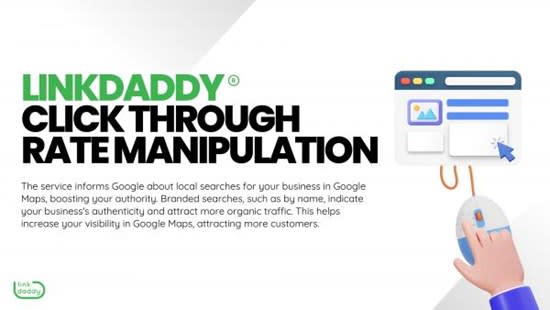CTR Manipulation Service-- Expert Providers to Improve Your CTR
CTR Manipulation Service-- Expert Providers to Improve Your CTR
Blog Article
CTR Control: A Game Changer for Digital Projects
The increase of CTR adjustment has indisputably changed electronic advertising and marketing strategies, offering marketing professionals with tools to enhance engagement and drive traffic efficiently. What effects might this stabilizing act hold for the future of electronic projects?
Comprehending CTR Control
Although click-through rate (CTR) manipulation might feel like a simple tactic in electronic advertising and marketing, it encompasses a variety of techniques focused on synthetically inflating involvement metrics. This adjustment can take numerous forms, including the usage of click ranches, crawlers, or deceptive ad placements that deceive consumers into clicking. These approaches can endanger the stability of efficiency data, making it testing for online marketers to assess the authentic efficiency of their projects.
In addition, CTR control raises moral worries, as it threatens the transparency of electronic advertising and marketing. The dependence on inflated metrics can cause misguided advertising decisions, skewing resource allotment and campaign techniques. Companies might invest heavily in channels and strategies that appear successful however do not yield actual interaction or conversions.

Benefits of Click-Through Rate Optimization
Enhancing click-through rate (CTR) is crucial for improving the performance of electronic advertising campaigns. A greater CTR indicates that a bigger percentage of individuals are engaging with the material, which can lead to boosted internet site web traffic and better conversion rates. By improving CTR, brand names can properly allocate their marketing resources to efforts that yield the highest returns.
One of the main advantages of CTR optimization is the capacity for enhanced advertisement positioning and reduced costs - CTR Manipulation. Platforms like Google Advertisements reward higher CTRs with far better advertisement positioning and minimized cost-per-click (CPC), enabling marketing experts to stretch their budgets better. In addition, a well-optimized CTR can improve brand exposure, as higher involvement rates often associate with enhanced natural reach

Methods for Effective CTR Adjustment
To effectively control click-through rates (CTR), online marketers can use a variety of strategic methods that improve user engagement and drive traffic. One basic method is optimizing advertisement duplicate to produce engaging and action-oriented language. CTR Manipulation. Using solid call-to-action (CTA) expressions encourages individuals to take instant activity, raising the likelihood of clicks
An additional effective technique is A/B testing, which allows marketing experts to contrast different ad variants. By methodically examining efficiency metrics, they can recognize which elements reverberate finest with the target market, thus improving their methods for maximum influence. Additionally, leveraging aesthetically appealing graphics and succinct messaging can catch interest promptly, making it more probable that individuals will certainly engage.

Last but not least, maximizing landing web pages to ensure a seamless customer experience can lower bounce rates and motivate find out this here further communication, ultimately promoting greater CTR. By integrating these methods, marketing experts can properly control CTR to achieve their campaign goals.
Gauging Success in Digital Projects
Measuring success in electronic campaigns needs a clear understanding of essential performance indications (KPIs) that align with project objectives. KPIs act as measurable metrics that help analyze the performance of numerous approaches employed throughout the project. Usual KPIs include click-through prices (CTR), conversion prices, price per procurement (CERTIFIED PUBLIC ACCOUNTANT), and roi (ROI)
To properly measure success, it is crucial to establish details, quantifiable objectives at the start of the campaign. For instance, if the primary goal is to enhance brand name recognition, metrics such as perceptions and interaction prices may be prioritized. On the other hand, campaigns concentrated on straight sales would certainly take advantage of a much more detailed evaluation of conversion prices and profits created.
Normal evaluation of these KPIs enables marketers to make data-driven choices, maximizing their approaches in real-time. Making use of analytical devices can aid in tracking performance and identifying fads, enabling swift changes to boost project results. Eventually, a detailed approach to measuring success not only highlights areas for renovation yet also enhances the total performance of electronic marketing initiatives, driving continual growth and involvement in the long term.
Future Trends in Digital Advertising
Expecting the future of electronic advertising reveals a landscape formed by rapid technical improvements and altering consumer behaviors. As synthetic intelligence and device discovering proceed to evolve, marketers will progressively take advantage of these modern technologies to customize projects at an unprecedented scale. Anticipating analytics will allow brand names to prepare for client requirements, maximizing advertisement placements and content delivery in real time.
Moreover, the surge of voice search and wise gadgets is transforming just how consumers communicate with digital content. Marketers will certainly need to adjust their strategies to make sure visibility across multiple platforms, consisting of voice-activated assistants. This change requires a focus on conversational advertising and marketing, emphasizing interaction through dialogue as opposed to traditional promotional techniques.
Furthermore, personal privacy issues are motivating changes in data collection techniques. Openness and ethical data usage click to read will come to be critical, driving brand names to cultivate trust and commitment among customers. The ongoing development of social networks platforms will certainly also influence marketing methods, with an enhanced emphasis on authenticity and user-generated web content.
Final Thought
In recap, CTR manipulation stands for a significant development in digital advertising and marketing strategies, using instant advantages with improved interaction metrics. However, the moral factors to consider surrounding such techniques necessitate a cautious strategy to guarantee lasting brand name honesty and real target market connection. By striking an equilibrium in between optimization techniques and genuine interaction, why not try these out marketers can grow lasting relationships with customers. The ongoing advancement of digital advertising will certainly depend on this delicate interaction, shaping the future landscape of brand-consumer communications.
Report this page